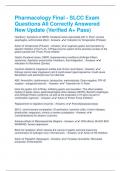Pharmacology Final - SLCC Exam
Questions All Correctly Answered
New Update (Verified A+ Pass)
Heartburn, Symptoms of GERD, Duodenal ulcers associated with H. Pylori, erosive
esophagitis, antimicrobial effect - Answers -✔✔ Indication for Omeprazole (Prilosec)
Action of Omeprazole (Prilosec) - Answers -✔✔ suppress gastric acid secretion by
specific inhibition of the H+/K+ ATPase enzyme system at the secretory surface of the
gastric parietal cell. Proton Pump Inhibitor
Gastric Duodenal ulcers, GERD, Hypersecretory conditions (Zollinger-Ellison
syndrome), Aspiration pneumonitis, Heartburn, Acid indigestion. - Answers -✔✔
Indication for Ranitidine (Zantac)
Cautions related to magnesium sulfate and chronic renal failure - Answers -✔✔
Kidneys cannot clear magnesium and it could cause hypermagnesmia. Could cause
dehydration and electrolyte loss from diarrhea.
ABX. Amoxicillin, clarithromycin, tetracycline, metronidazole. Gram-negative. PPI-H2
receptor - antagonist bismuth. - Answers -✔✔ Treatment for H. Pylori
block the gastric H,K-ATPase, inhibiting gastric acid secretion. This effect enables
healing of peptic ulcers, gastroesophageal reflux disease (GERD), Barrett's esophagus,
and Zollinger-Ellison syndrome, as well as the eradication of H-pylori as part of
combination regimens. - Answers -✔✔ Action of Proton Pump Inhibitors
Replacement for digestive enzymes - Answers -✔✔ Pancrelipase/pancrease
IBS-C, chronic/severe constipation, GI perforation, ischemic colitis, Crohn's disease,
diverticulitis, megacolon, chronic or severe constipation - Answers -✔✔
Contraindications for alostron (Lotrinex)
Adverse effects of Metoclopramide (Reglan) - Answers -✔✔ CNS effects. BLACK BOX
WARNING: Severe depression.
Block H2 receptors, which reduces the volume of gastric acid and lowers the
concentration of hydrogen ions in the stomach. - Answers -✔✔ Action of H2 inhibitors
Action of Filgrastim (Neupogen) - Answers -✔✔ Increase neutrophils. Stimulates
production of Neutrophils.
, Labs to monitor effectiveness of heparin - Answers -✔✔ PTT
inactivating thrombin and preventing the conversion of fibrinogen to fibrin. It also
prevents the formation of a stable fibrin clot in inhibiting the activation of the fibrin
stabilizing factor. - Answers -✔✔ Action of Heparin
Dependent on adequate quantities of iron, folic acid, vitamin B12. - Answers -✔✔
Factor that promotes effectiveness of epoetin alfa
Action of alteplase (Activase) - Answers -✔✔ binds to the fibrin in a clot and converts
the plasminogen back to plasmin.
Antidote for Heparin - Answers -✔✔ Protamine
prevent clotting by activating antithrombin, indirectly inactivating both thrombin and
factor Xa - Answers -✔✔ Action of anticoagulant
bind to the fibrin in a clot and convert the plasminogen back to plasmin. Assist in the
dissolving of a clot. - Answers -✔✔ Action of thrombolytics
Drug used for symptomatic bradycardis/anticholinergic - Answers -✔✔ Atropine
N/V/D, ABD pain, peripheral vasodilation, salivation, diaphoresis, bradycardia, bronchial
constriction. - Answers -✔✔ Cholinergic Crisis
Muscle weakness, SOB, difficulty swallowing, respiratory insufficiency, quadriparesis,
quadriplegia. - Answers -✔✔ Myasthenia Crisis
A challenge dose of edrophonim (Tension) is given. If the symptoms of a patient with
improves after the dose, it means they needed more cholinergic stimulation and their
standing treatment is inadequate. If there is no relief of symptoms or if an increase in
muscle weakness follows, then the patient is receiving too much. - Answers -✔✔
Cholinergic Crisis vs. Myasthenia Crisis
Atropine - Answers -✔✔ Antidote for Cholinergic Crisis
Important nursing interventions to remember when administering dopamine - Answers -
✔✔ Monitor BP every 15 min. Monitor for extravasation. Correct hypovolemia before
hanging.
Action of Fenoldopam - Answers -✔✔ Vasodilator. Decrease in BP, Hypotension
Main use for adrenergic drugs - Answers -✔✔ Fight or flight. A1, A2, B1, B2. Looking
for shock.




